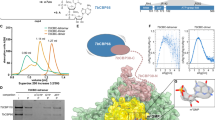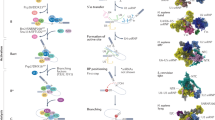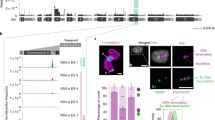Abstract
MOLECULAR genetic studies in parasitic protozoa have been hindered by the lack of methods for the introduction and expression of modified or foreign genes in these organisms. Two recent reports described the transient expression of the bacterial chloramphenicol acetyl transferase (CAT) gene under the control of parasite-specific sequences1,2. We now describe the stable expression of a selectable marker, the gene for neomycin resistance (neor) in Leishmania enriettii. A chimaeric gene containing the neor gene inserted between two α-tubulin intergenic sequences was introduced into the cells and drug-resistant L. enriettii were observed which stably expressed theneor gene. One goal of this work was to analyse the sequences necessary fortrans-splicing of messenger RNA, as try-panosomatids have a novel process of RNA trans-splicing, described initially in Trypanosome brucei3–5 and subsequently in several other trypanosomatids, including L. enriettii6. Many try-panosomatid genes are arranged in tandem arrays and the intergenic sequences contain both the splice acceptor site for the addition of the spliced leader sequence and a putative polyadenylation site6. Messenger RNA isolated from several differentneor L. enrietii lines contained the spliced leader sequence joined to the neor gene at the position of the splice acceptor site in the α-tubulin intergenic sequence. Theneor mRNA was also polyadenylated. Plasmid DNA is present within the drug-resistant organisms and appears to be extrachromosomal. The development of these methods allows the functional analysis of sequences necessary for trans-splicing.
This is a preview of subscription content, access via your institution
Access options
Subscribe to this journal
Receive 51 print issues and online access
$199.00 per year
only $3.90 per issue
Buy this article
- Purchase on SpringerLink
- Instant access to full article PDF
Prices may be subject to local taxes which are calculated during checkout
Similar content being viewed by others
References
Laban, A. & Wirth, D. Proc. natn. Acad. Sci. U.S.A. 86, 9119–9123 (1989).
Bellofato, V. & Cross, G. A. M. Science 244, 1167–1169 (1989).
Borst, P. A. Rev. Biochem. 55, 701–732 (1986).
Boothroyd, J. C. & Sutton, R. E. Cell 47, 527–535 (1986).
Murphy, W. J., Watkins, K. P. & Agabian, N. Cell 47, 517–525 (1986).
Landfear, S. M., Miller, S. I. & Wirth, D. F. Molec. Biochem. Parasitol. 21, 235–245 (1986).
Beverley, S. M., Coderre, J. A., Santi, D. V. & Schimke, R. T. Cell 38, 431–439 (1984).
Folger, K. R., Wong, E. A., Wahl, G. & Capecchi, M. R. Molec. Cell Biol. 2, 1372–1387 (1982).
Comeau, A. M., Miller, S. I. & Wirth, D. F. Molec. Biochem. Parasitol. 21, 161–169 (1986).
Wirth, D. F. & Slater, C. Molec. Biochem. Parasitol. 9, 83–92 (1983).
Beverley, S. M. Nucleic Acids Res. 16, 925–939 (1988).
Garvey, E. D. & Santi, D. V. Science 233, 535–540 (1986).
Southern, P. J. & Berg, P. J. molec. Genet. 1, 327–341 (1982).
Miller, S. I., Landfear, S. M. & Wirth, D. F. Nucleic Acids Res. 14, 7341–7360 (1986).
Author information
Authors and Affiliations
Rights and permissions
About this article
Cite this article
Laban, A., Tobin, J., de Lafaille, M. et al. Stable expression of the bacterial neor gene in Leishmania enriettii. Nature 343, 572–574 (1990). https://doi.org/10.1038/343572a0
Received:
Accepted:
Issue date:
DOI: https://doi.org/10.1038/343572a0



